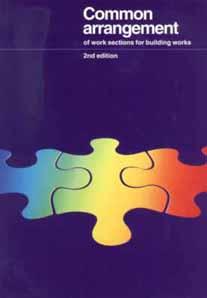
Tony Cunningham
Publication date 1998 Media type Print (Paperback) Pages 180 Common Arrangement of Work Sections, first published in 1987, is a industry working convention designed to promote standardisation of, and detailed coordination between, bills of quantities and specifications. It is part of an industry-wide coordinated projects information initiative (now managed by the ) and has been used for the arrangement of the, the National Engineering Specification and the Standard Method of Building Works (7th ed). The new edition aligns CAWS with the Unified Classification for the Construction Industry which was published in 1997. The Common Arrangement is the authoritative UK classification of work sections for building work, for use in arranging project specifications and bills of quantities. Over 300 work sections are defined in detail to give:. good coordination between drawings, specifications and bills of quantities.
predictability of location of relevant information. fewer oversights and discrepancies between documents. flexibility to the contractor in dividing the project information into work packages. The classification of work sections is separate from, and complementary to, the classification of other concepts such as building types, elements, construction products and properties/characteristics. Uniclass, published in 1997, is the definitive overall classification tables, one of which is for work sections for buildings, comprising the Common Arrangement group, sub-group and work section headings. See also. External links.

Design and Build of Passenger Terminal Building North Extension At Macau International Airport (RFQ - 198) Section 6 - Bill of Quantities Bill Nr. 2 Design of the Works Item Quantity Unit Rate (MOP$) Amount (MOP$) A Contractor's Other Costs Contractor's other costs for any item of work or obligation which is necessary for the completion of the.
This article about a book on or is a. You can help Wikipedia.
Publication date 1998 Media type Print (Paperback) Pages 180 Common Arrangement of Work Sections, first published in 1987, is a industry working convention designed to promote standardisation of, and detailed coordination between, bills of quantities and specifications. It is part of an industry-wide coordinated projects information initiative (now managed by the ) and has been used for the arrangement of the, the National Engineering Specification and the Standard Method of Building Works (7th ed). M33 installation package scan. The new edition aligns CAWS with the Unified Classification for the Construction Industry which was published in 1997. The Common Arrangement is the authoritative UK classification of work sections for building work, for use in arranging project specifications and bills of quantities. Over 300 work sections are defined in detail to give:. good coordination between drawings, specifications and bills of quantities. predictability of location of relevant information.
fewer oversights and discrepancies between documents. flexibility to the contractor in dividing the project information into work packages. The classification of work sections is separate from, and complementary to, the classification of other concepts such as building types, elements, construction products and properties/characteristics. Uniclass, published in 1997, is the definitive overall classification tables, one of which is for work sections for buildings, comprising the Common Arrangement group, sub-group and work section headings. See also.
Measurement

External links. This article about a book on or is a. You can help Wikipedia.